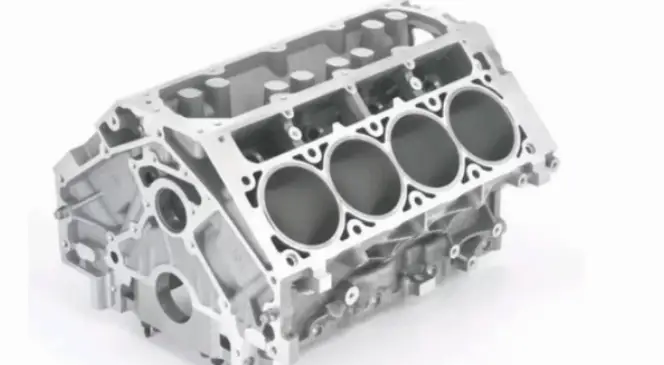An engine is a machine device to convert one form of energy into mechanical energy. Heat engines burn fuel to create heat, which is utilized to perform useful work. It is a complex machine built to convert heat from burning gas into the force that turns the wheels. The engine has two types: internal combustion engine and external combustion engine. Internal combustion engines burn their fuel inside the engine cylinder, while external combustion engines burn their fuel outside the cylinder. The engine is one of the most essential parts of the automobile industry, or we can also say that the engine is the heart of an automobile.
Main parts of a car engine are cylinder block, cylinder head, crankcase, oil pan, manifolds, gaskets, cylinder liners, pistons, piston rings, piston pin, connecting rod, crankshaft, camshaft, flywheel, and engine valve. Now let’s take a look at each engine part with details.
Cylinder Block or Engine Block:
The cylinder block is the main fundamental part of an engine. It consists of three parts: the cylinder in which the pistons slide up and down, the port or opening for the valve, and the passage for the flow of cooling water. The cylinder block is usually made of gray cast iron or aluminum and its alloys. Other parts like timing gear, water pump, ignition distributor, flywheel, fuel pump, and coolant passages are attached to it.

Cylinder Head:
The cylinder head is another main part of an engine, usually made of cast iron and aluminum alloy. It is attached to the cylinder block using studs and gaskets to provide a tight, leak-proof joint. The cylinder head contains a combustion chamber above each cylinder and features valve guides, valve seats, ports, coolant jackets, and threaded holes for spark plugs. There are three types of cylinder heads: loop flow type, offset cross flow type, and inline cross flow type.
Crankcase:
The crankcase is the housing that surrounds the crankshaft and is the bottom portion of the cylinder block. It is made of gray cast iron or aluminum and can be cast integrally with the block or separately attached with bolts. The crankcase provides support for the main journals and bearings of the crankshaft, maintaining alignment under various engine loads.
Oil Pan or Sump:
The oil pan or sump is attached to the bottom of the engine through bolts and a gasket to make the joint leak-proof. It serves as a reservoir for storing, cooling, and ventilating engine lubricating oil. A drain plug is provided for oil replacement, and it is generally made of pressed steel sheet or aluminum alloy.
Manifolds:
Manifolds are separate sets of pipes attached to the cylinder head, carrying the air-fuel mixture and exhaust gases. They are typically made of cast iron to withstand high temperatures.
Gaskets:
Gaskets are used to provide a tight-fitting joint between two surfaces. They are found in joints between the cylinder head and the cylinder block, crankcase and oil pan, and cylinder block and manifold. Materials used for gaskets include cork, asbestos, rubber, and cylinder liners.
Cylinder Liners or Cylinder Sleeves:
Cylinder liners, or sleeves, are cylindrical-shaped liners used to prevent cylinder wear. They are made of special alloy iron and can be replaced after wearing out. There are two types of cylinder liners: dry liners and wet liners.
Pistons:
Pistons are cylindrical plugs that move up and down in the cylinder, converting pressure energy from combustion into useful power. Pistons have three to five piston rings that provide a seal between the cylinder wall and the piston. They are made of cast iron or aluminum alloy and can be either cast or forged.
Piston Rings:
Piston rings are fitted into grooves on the piston to maintain a good seal between the piston and cylinder wall. There are two types of piston rings: compression rings and oil control rings.
Connecting Rod:
The connecting rod is fitted between the piston and crankshaft, converting the reciprocating motion of the piston into the turning motion of the crankshaft. It is typically made of alloy steel with an I-beam cross-section.
Piston Pin:
The piston pin, also known as the wrist pin or gudgeon pin, connects the small end of the connecting rod to the piston. It is made hollow to reduce weight and is usually constructed from case-hardened steel. There are three types of piston pins: set screw types, semi-floating piston pins, and fully floating piston pins.
Crankshaft:
The crankshaft is the engine component that transmits power. It converts the piston’s reciprocating motion into a rotating motion. The crankshaft is made of heat-treated alloy steel casting or forging and consists of crank pins, main journals, balancing weights, and oil holes.
Camshaft:
The camshaft is a shaft with mounted cams that open the engine valves. It is driven by the crankshaft and has gear drive, chain drive, or belt drive mechanisms. The camshaft is made from forged alloy steel.
Flywheel:
The flywheel is a heavy steel wheel attached to the rear end of the crankshaft. Its size depends on the engine’s construction, and its inertia helps keep the crankshaft running at a constant speed.
Engine Valves:
Engine valves control the timing of air-fuel mixture entry and combustion product exit from the cylinders. They are located at the inlet and outlet openings of the engine cylinder and are made of high-heat-resistant metals such as chromium, nickel, or tungsten steel.
An experienced automotive enthusiast and industry expert, we brings lot of knowledge to every article. Specializing in vehicle reviews, maintenance tips, and the latest automotive trends